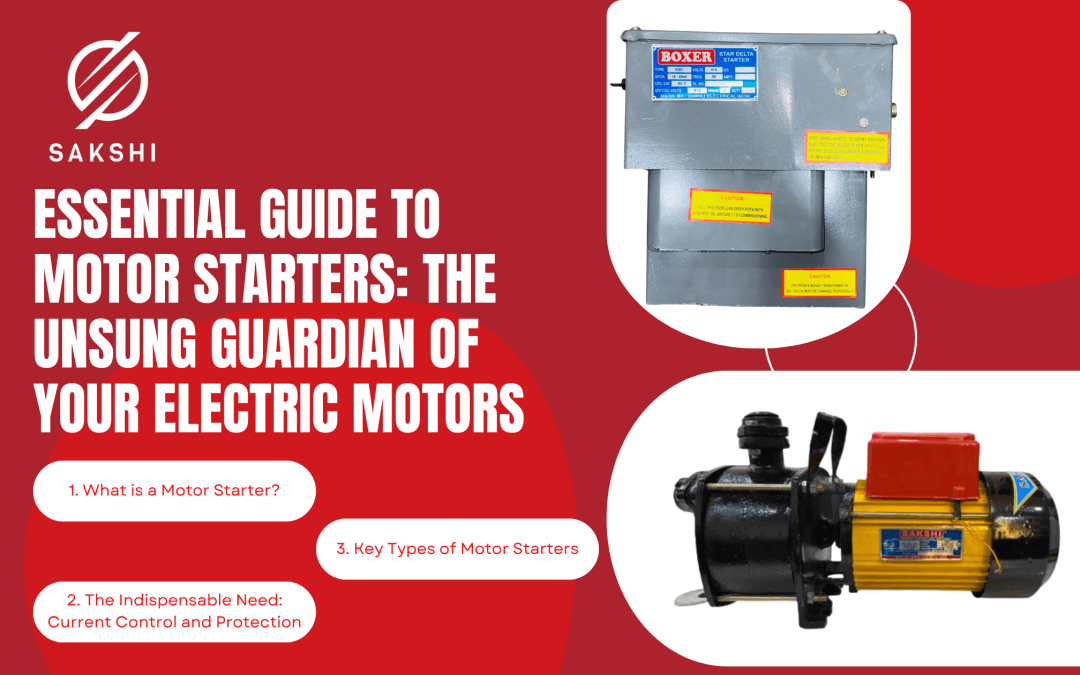Introduction: Why Your Motor Needs a Starter
In the world of industrial and commercial operations, the electric motor is the powerhouse, driving everything from pumps and compressors to conveyor belts. But simply connecting a motor directly to the power supply is a recipe for disaster. This is where the Motor Starter comes in—it’s the critical link between the power grid and your motor, serving as both a controller and a protector.
At Dhiraj Electrical India, we understand that reliable motor operation is non-negotiable. This blog will break down what a motor starter is, why it’s indispensable, and the different types you encounter in the electrical landscape.
1. What is a Motor Starter?
A motor starter is an electrical device that controls the flow of power to an electric motor during its starting, running, and stopping phases.
In essence, a motor starter has two primary, critical functions:
- Connect and Disconnect Power: It provides a safe means to switch the motor ON and OFF.
- Motor Protection: It incorporates mechanisms to protect the motor from damage caused by electrical faults, primarily overload and under-voltage.
A starter typically consists of two main components housed together: the Contactor (for switching the circuit) and the Overload Relay (for protection).
2. The Indispensable Need: Current Control and Protection
Two phenomena make a motor starter absolutely essential:
A. Taming the Inrush Current ⚡
When an AC induction motor starts, it draws a massive surge of current, often 6 to 8 times its normal full-load current (FLC). This is known as the inrush current.
- System Damage: Such a high current can cause significant voltage dips in the electrical system, potentially affecting other connected equipment.
- Motor Damage: The prolonged exposure to excessive current generates intense heat, which can quickly degrade the motor’s winding insulation, leading to premature failure.
The main job of most starters (excluding DOL for large motors) is to limit this starting current, allowing the motor to accelerate smoothly without stressing the electrical infrastructure or the motor itself.
B. Overload Protection 🛑
The second vital function is continuous protection. If a motor is mechanically overloaded (e.g., a pump is jammed, or a conveyor belt is carrying too much weight), it will draw more current than its design rating (FLC). A thermal or electronic overload relay inside the starter monitors this current and trips the circuit, shutting down the motor before the sustained high current causes thermal damage to the windings.
3. Key Types of Motor Starters
The selection of a motor starter depends entirely on the motor size, the application requirements, and the level of current reduction needed.
| Starter Type | Motor Size Suitability | Primary Function | Principle of Operation |
| Direct-On-Line (DOL) | Small (up to 5-10 HP) | Simple ON/OFF with Protection | Applies full line voltage immediately. |
| Star-Delta (Y-Δ) | Medium (10 HP to 50 HP) | Reduce starting current by 1/3. | Starts in Star (low voltage), runs in Delta (full voltage). |
| Soft Starter | Medium to Large | Smooth acceleration/deceleration. | Uses solid-state SCRs (Thyristors) to ramp up voltage gradually. |
| Variable Frequency Drive (VFD) | All Sizes | Full control over speed and torque. | Converts AC to DC and back to variable frequency AC. |
VFDs: The Ultimate Control System
While traditional Star-Delta and Soft Starters focus on reducing starting current, the Variable Frequency Drive (VFD), also known as an AC Drive or Inverter, offers the most advanced control. A VFD starts the motor at a low frequency and voltage, resulting in minimal inrush current and the ability to control the motor’s speed and torque continuously—a huge advantage for energy savings and process optimization.
Conclusion: Invest in Protection, Ensure Longevity
The motor starter is not just a regulatory component; it is an investment in the longevity and reliability of your industrial assets. By properly managing the harsh realities of motor startup and providing continuous overload monitoring, it ensures your operations run smoothly, safely, and without unexpected downtime.
Are you looking to upgrade your motor protection or implement advanced speed control with VFDs?
Explore our extensive range of reliable and robust motor control solutions tailored for the Indian industrial environment. Contact the experts at Dhiraj Electrical India today for guidance on selecting the perfect starter for your application!



